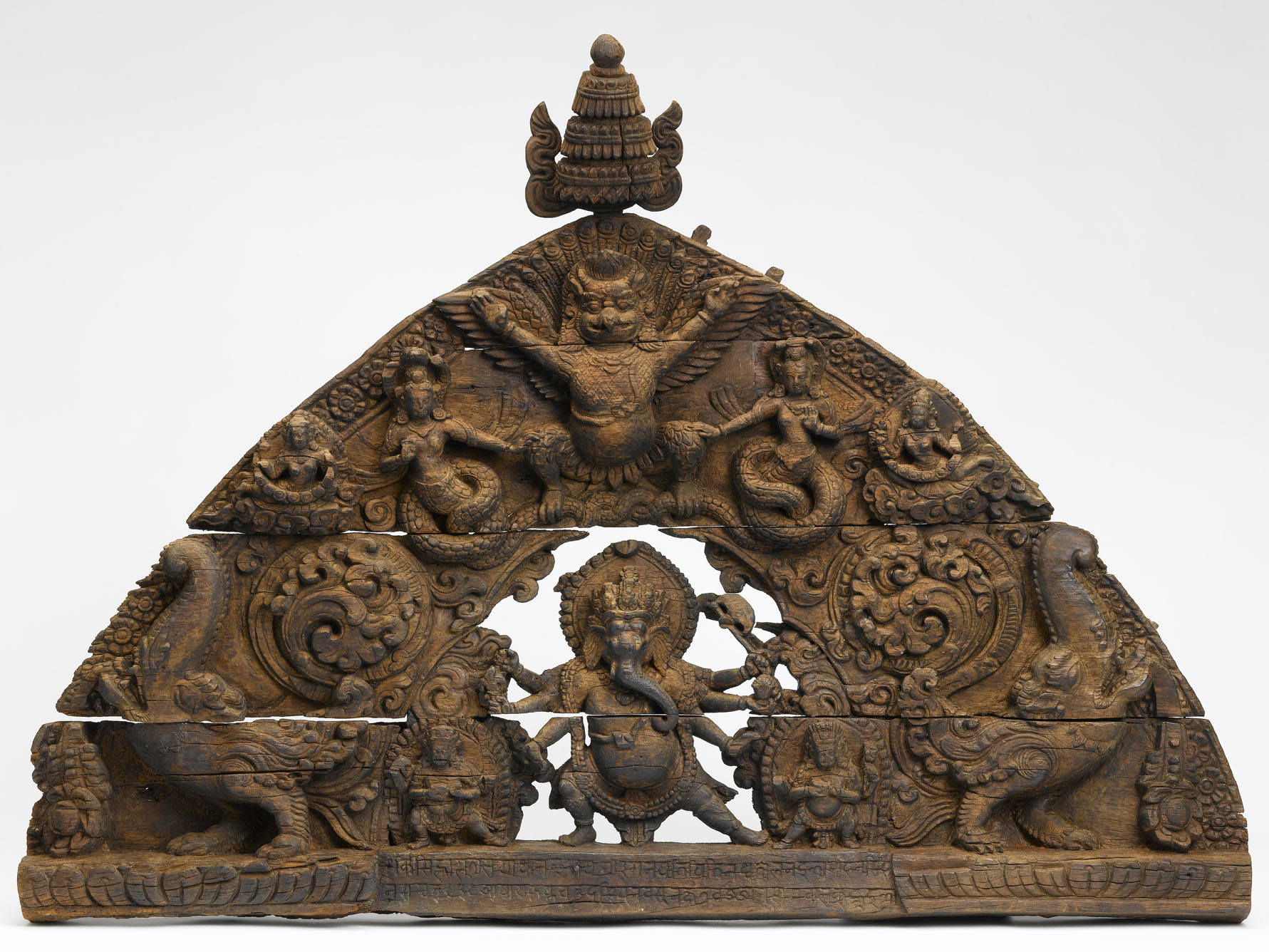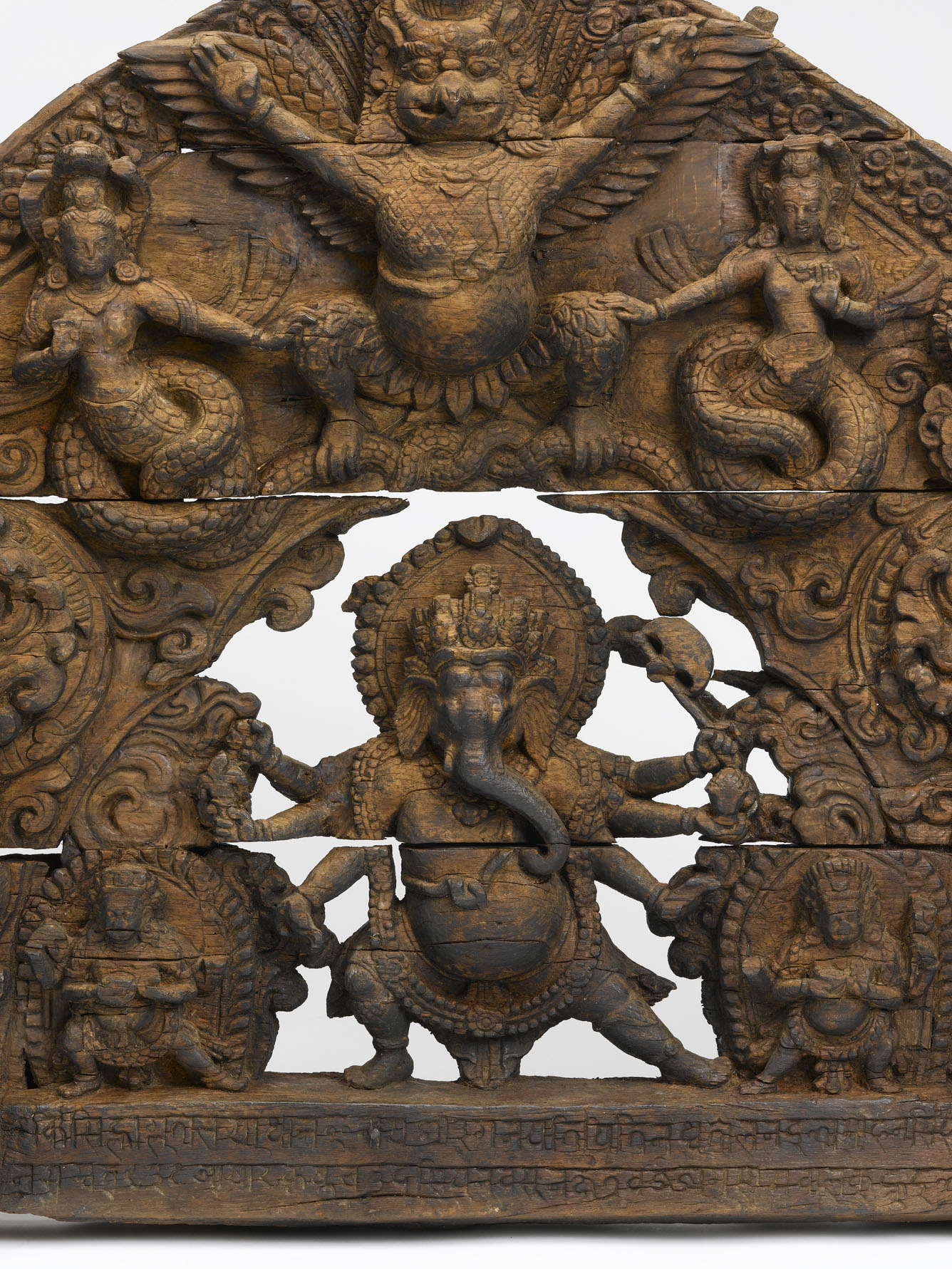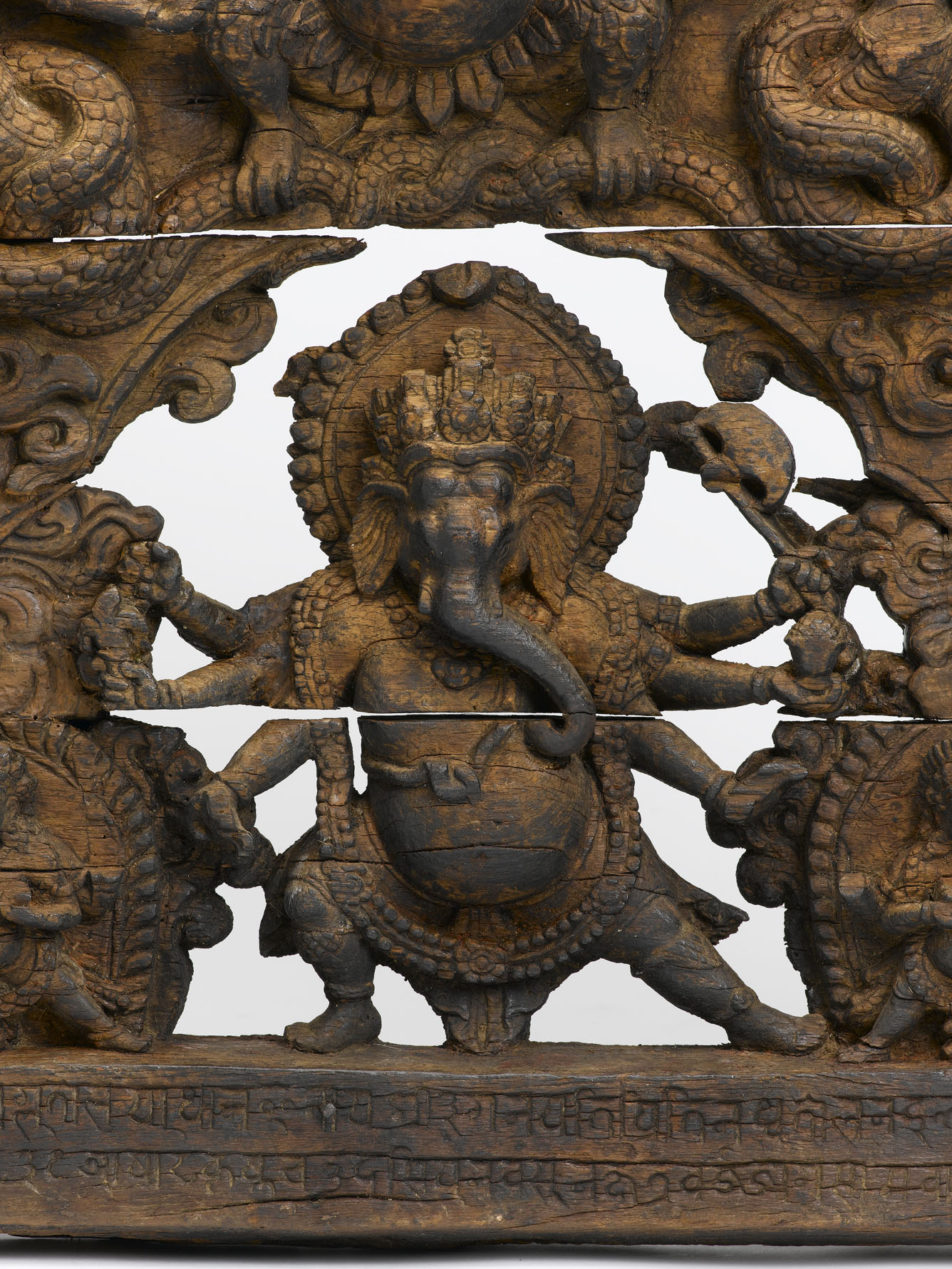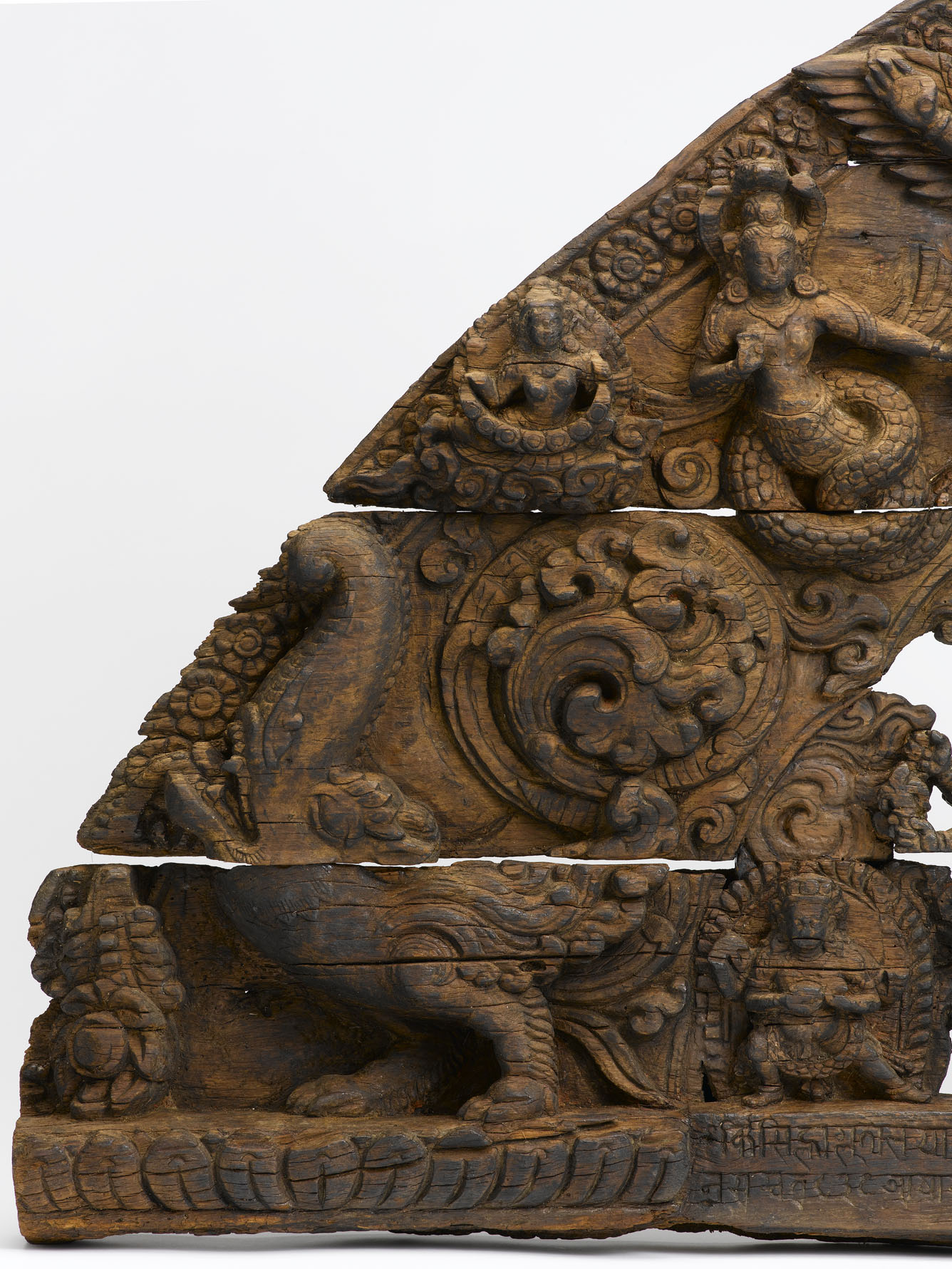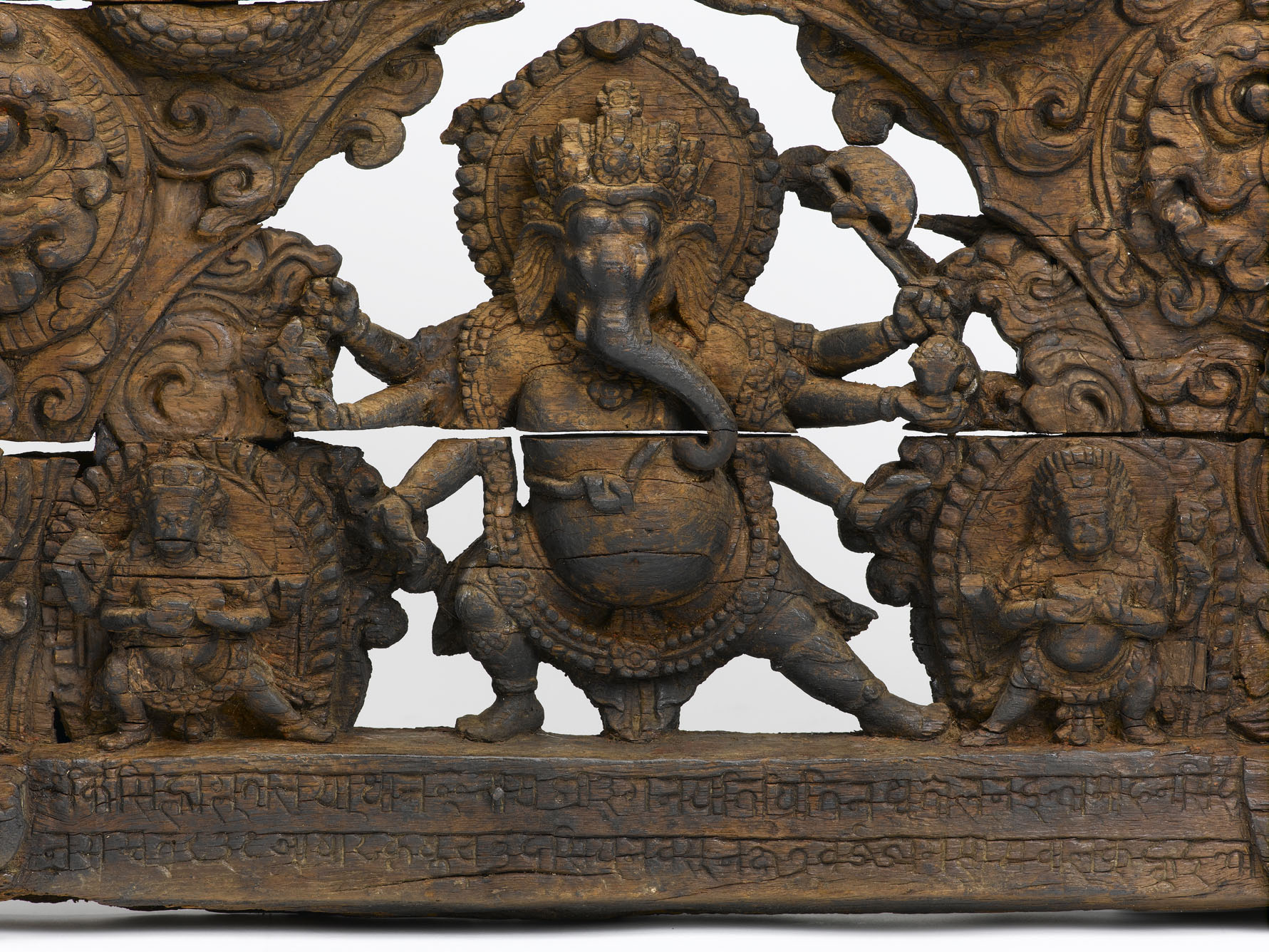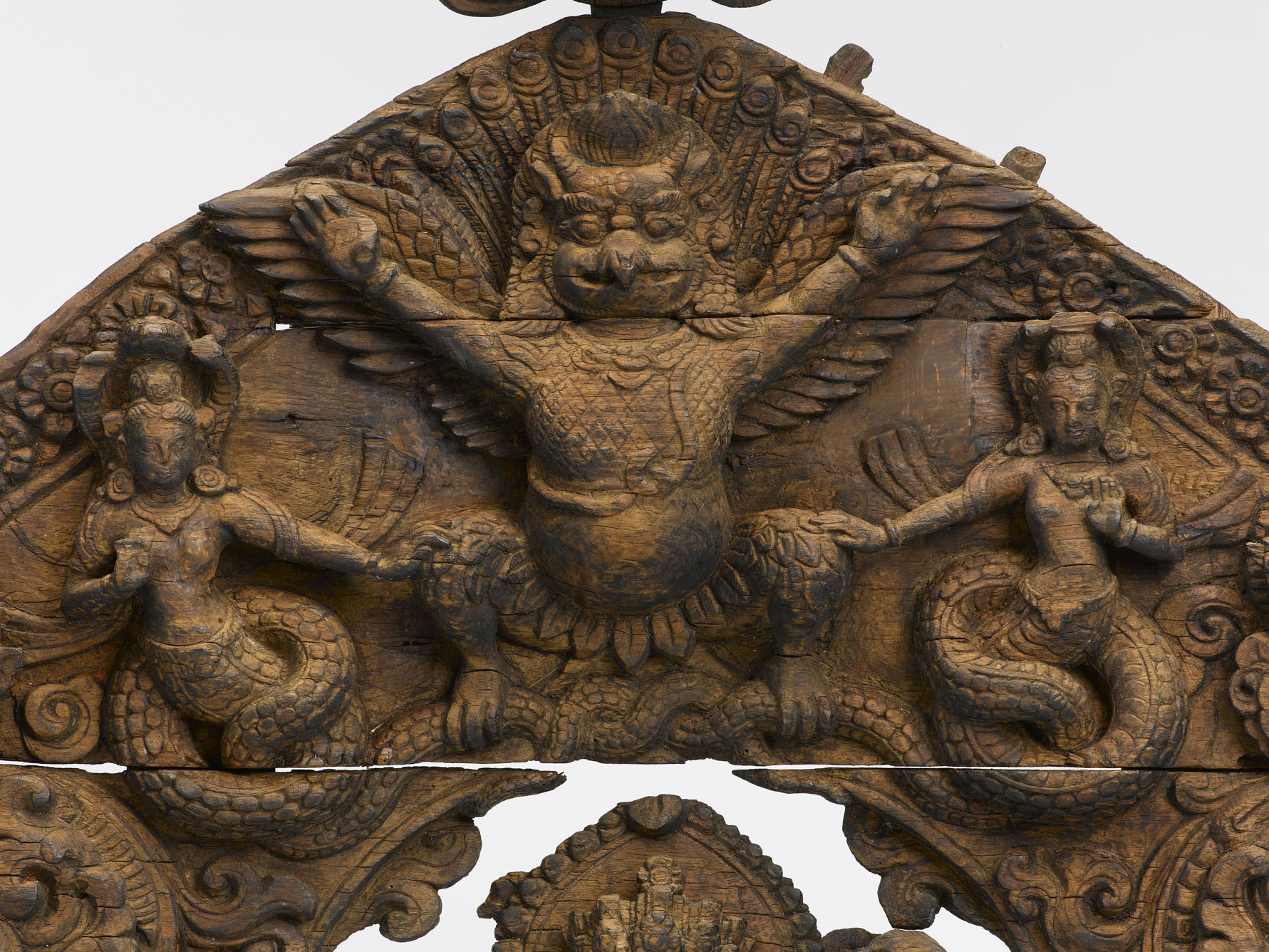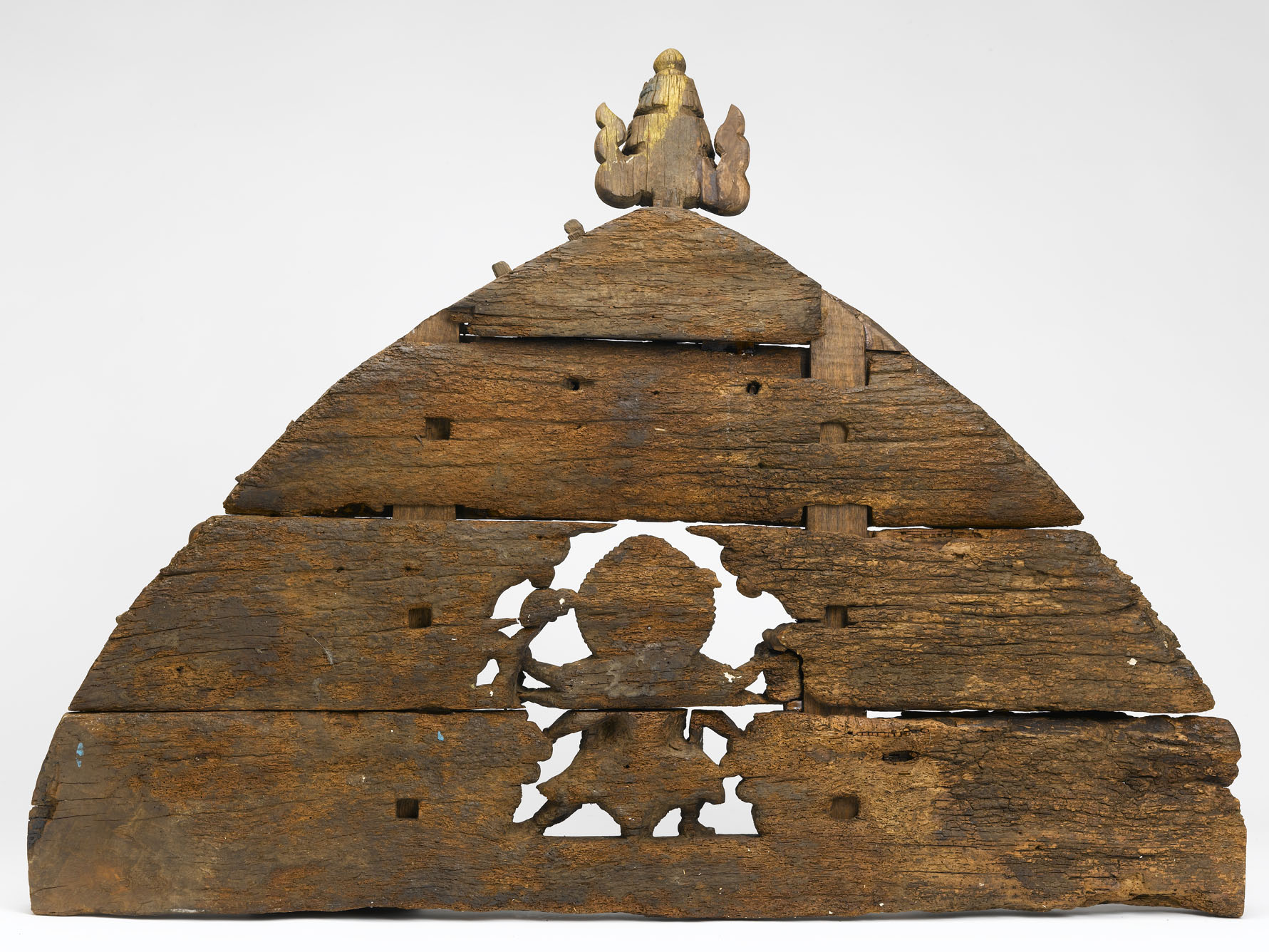“Torana” dedicated to Ganesha dated 839 Samvat newary (1719 C.E.) 18th centuryNepal Valley - wood - long 115.5cm - h. 82.5cm - D. 9.5cm -
Large semicircular wood carvings such as this one, in the shape of a lunette and hence called “chandrasala”, are commonly designated with another Sanskrit term, toraˆa (pron. “tòrana”), referring in particular to the tympanum of gateways giving access to stupas in India. In the Nepal Valley such carvings, sometimes covered with gilded copper sheathing, are placed above entries to shrines and represent a typical feature of traditional Newar religious architecture. Unlike its Indian freestanding models, the Newar “tòrana” leans slightly forward, its basis resting on the door’s lintel and its upper portion being attached by means of iron chains or rods to the wall behind1. Quite appropriately, the holes made in this wood carving to fix it to the wall of its shrine were filled during careful restoration in such a way as to leave their location visible. This “tòrana” was placed above the entry to a shrine devoted to Ganesha in the locality of Kisihlâgla, corresponding to Kilagal-tol, Kathmandu, as pointed out by the Newar scholar Gautama Vajrâcharya, who transliterated and translated its two-line inscription as follows: 1. om kisihlågla tolayā thåna inåya śr¥ 3 ganapati pritina thva tolana duntå mohana siμha 2. na samvat 836 å∑å∂ha k®∑ˆa caturdasi punuvasu nak∑atra vajajoga somavala kuhnu duntå. “In order to please Śr¥ 3 Gaˆapati, who is (the main) Gaˆeśa of Kisihlāgla locality, Mohana Siμha donated this toraˆa in Nepal Samvat 839 (corresponding to 1719 CE), on the fourteenth day of the Ā∑å∂ha month, Monday, Punarvasu Nak∑atra,Vajra Yoga.” From the inscription, dedicated by the donor, Mohana Siμha, to the “thrice glorious Ganapati”, another name for Ganesha, we gather that the “tòrana” with its shrine were consecrated after an appropriate ritual to the elephant-headed god on a Monday in the month of Ashâdha of the Newar year 839, corresponding 1719 CE, “Vajra Yoga”. As pointed out by Gautama Vajracharya, Vajra (“Vaja” in the inscription) Yoga is one of the twenty-seven yogas in the Indic system of reckoning time known as Panchânga (“Five Limbs”). Panchânga is the Hindu almanac used by astrologers to select an auspicious day and time, in this case for the erection of a shrine devoted to Ganesha: a Monday in the month of Ashâdha, falling in June-July, in the lunar mansion of Punarvasu, corresponding to our Gemini, a constellation particularly favoured for building in the Nepal Valley2. That auspicious date was related to a suitable kind of yoga, in this case the Vajra one, which is the sixteenth in the series of twenty-seven, and is associated with wealth and strength. 1 Cf.MaryShepherdSlusser,TheAntiquityofNepalseWoodCarving.AReassessment,Universityof Washington Press, Seattle, 2010, p. 207. 1 The neighbourhood (tol) of Kilagal, in Kathmandu, is important not only because it is the seat of a local living goddess (Kumârî, “Virgin”) selected from the Newar farmers’ (Jyapu) caste, but also because there rises the important Buddhist monastery of Jana, devoted to a famous manifestion of the Bodhisattva Avalokitèshvara known as Sveta Matsyendranâtha. The cult of Ganesha in Nepal dates from the 4th century, when the country came to be ruled by the Indian dynasty of the Licchavis, and from the 15th century the god’s popularity overshadowed that of his elder brother, Kârtikkeya. The popularity enjoyed by Ganesha in Nepal is huge: shrines are devoted to him in every neighbourhood in the Valley and several male babies are given his name. As in the case of the most important deities, such as Vishnu, four sanctuaries were dedicated to him in strategic positions, guarding the four sections of the Nepal Mandala or Valley. Ganesha’s importance is due to his power of eliminating or creating obstacles, a gift that he received from his father, Shiva, to make up for the curse cast by the latter’s consort, Parvatî, furious because the handsome Ganesha was the fruit of a fling by her husband, and deformed her stepson giving him the head of an elephant and a huge belly. A number of legends accounts for Ganesha’s features and attributes, but his remote origins are probably to be found in the host of demigods and theriomorphic demons belonging to Shiva’s retinue, and known as “Ganas”, of whom Ganesha ended up becoming the chief as shown by his name, which is the contraction of a compound epithet meaning Ganas’ Lord (Ishvara). Ganesha’s image may be also carved or painted on the wooden struts supporting the roofs of Newar religious buildings and palaces. His chief attributes are the axe, held in his upper left hand, the noose, held in his lower left hand, the plate — here a bowl — of sweet, held in his middle left hand, the elephant goad, held in his lower right hand, the broken tusk, held in his middle right hand, and the rosary (mâlâ), held in his upper right hand. In Nepal the broken tusk is regularly replaced with a white radish that is part of the Nepalese traditional diet and is represented with the leaves protruding out of the root. Ganesha wears a snake as a necklace and is flanked here by two manifestations of his father, Shiva — to whose phallic manifestation the state temple of Pashupatinâtha is dedicated in the Nepal Valley — here in his wrathful aspect of Bhàirava. The triad is surrounded by an arch displaying Gàruda flying at the top, under a canopy of snakes and a royal parasol, his wings fully opened and his claws grasping the bodies of the King and Queen of Snakes (Nâgas), the guardians of the treasures hidden in the depths of waters and of the earth. Gàruda is the carrier of the god of preservation, Vishnu, of whom the rulers of the Nepal Valley were regarded as manifestations, and the “tòrana” was carved when Kathmandu was ruled by king Mahindrasimha, of the Malla dynasty, who is remembered for having invited Muslim people to settle in the city to manufacture perfumes and bangles, and to serve as court musicians3. A pair of huge Màkaras, sea-monsters dwelling in the ocean, vomit garlands of jewels, standing with their short legs on lotus flowers at the sides of the triad, while two celestial nymphs 2 (Àpsarases) seated on clouds move across the sky to bring garlands of flowers to Ganesha in this well-balanced composition whose iconographic programme conjures up notions of prosperity and protection. Proff. Erberto Lo Bue
Wooden Toraṇa Inscription:
2. na samvat 839 āṣāḍha kṛṣṇa caturdasi punuvasu nakṣatra vajajoga somavala Translation In: order to please Śrῑ 3 Gaṇapati, who is (the main) Gaṇeśa of Kisihlāgla locality, Mohana Siṃha donated this toraṇa in Nepal Samvat 839 (corresponding to 1719 CE), on the fourteenth day of the Āṣāḍha month, Monday, Punarvasu Nakṣatra, Vajra Yoga.
Thank you for your kind translation: Profs.Gautama Vajracharya Thus sri sri sri Ganesa means it is a name of a deity. If Ganesa is the name of a person only one sri is used. But for a monarch two sris. In our inscription sri 3 Ganapati means sri sri sri the great god Ganapati. Thank you for your kind translation: Dott.Gautama Vajracharya Provenance: European private collection Purchased before 1970
|
